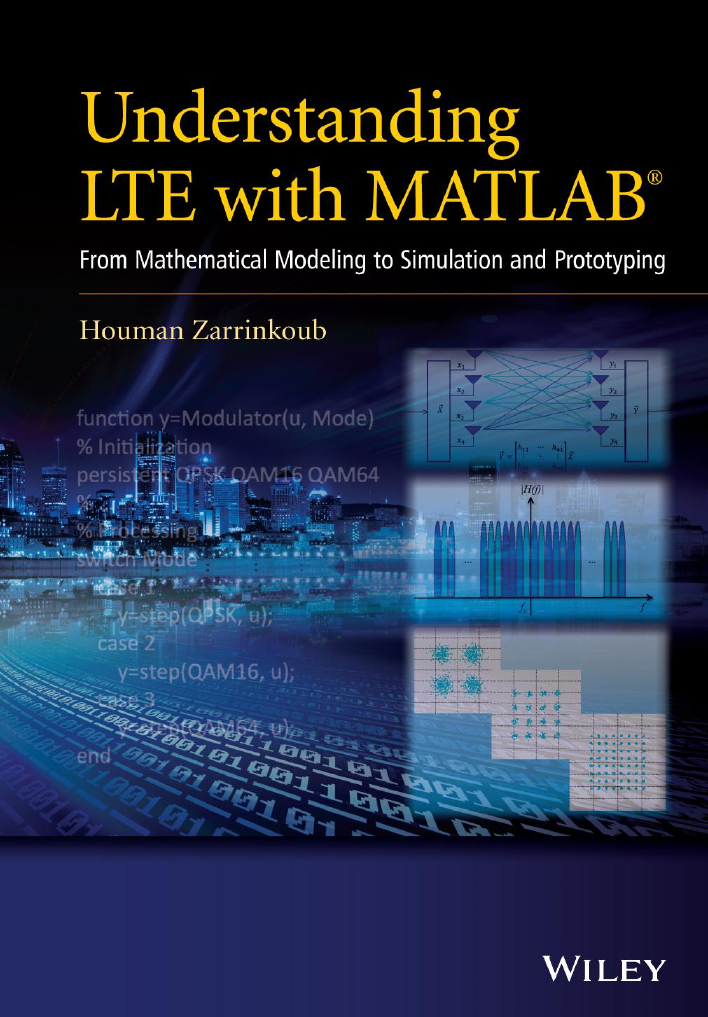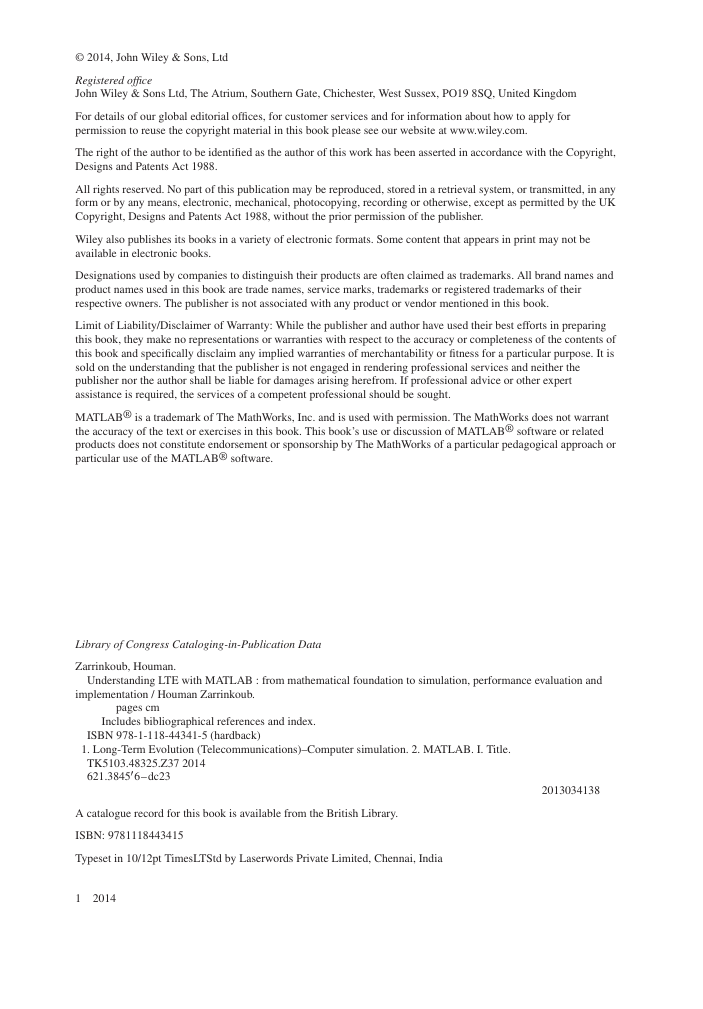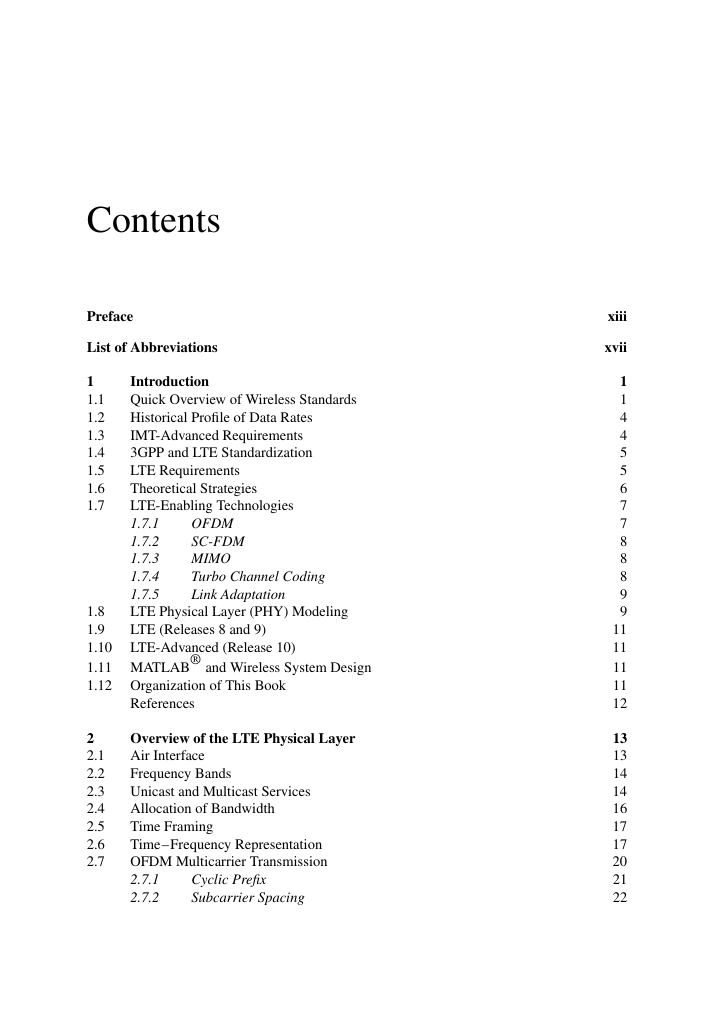�
UNDERSTANDING LTE
WITH MATLAB®
�
�
UNDERSTANDING LTE
WITH MATLAB®
FROM MATHEMATICAL MODELING
TO SIMULATION AND PROTOTYPING
Dr Houman Zarrinkoub
MathWorks, Massachusetts, USA
�
© 2014, John Wiley & Sons, Ltd
Registered office
John Wiley & Sons Ltd, The Atrium, Southern Gate, Chichester, West Sussex, PO19 8SQ, United Kingdom
For details of our global editorial offices, for customer services and for information about how to apply for
permission to reuse the copyright material in this book please see our website at www.wiley.com.
The right of the author to be identified as the author of this work has been asserted in accordance with the Copyright,
Designs and Patents Act 1988.
All rights reserved. No part of this publication may be reproduced, stored in a retrieval system, or transmitted, in any
form or by any means, electronic, mechanical, photocopying, recording or otherwise, except as permitted by the UK
Copyright, Designs and Patents Act 1988, without the prior permission of the publisher.
Wiley also publishes its books in a variety of electronic formats. Some content that appears in print may not be
available in electronic books.
Designations used by companies to distinguish their products are often claimed as trademarks. All brand names and
product names used in this book are trade names, service marks, trademarks or registered trademarks of their
respective owners. The publisher is not associated with any product or vendor mentioned in this book.
Limit of Liability/Disclaimer of Warranty: While the publisher and author have used their best efforts in preparing
this book, they make no representations or warranties with respect to the accuracy or completeness of the contents of
this book and specifically disclaim any implied warranties of merchantability or fitness for a particular purpose. It is
sold on the understanding that the publisher is not engaged in rendering professional services and neither the
publisher nor the author shall be liable for damages arising herefrom. If professional advice or other expert
assistance is required, the services of a competent professional should be sought.
MATLAB® is a trademark of The MathWorks, Inc. and is used with permission. The MathWorks does not warrant
the accuracy of the text or exercises in this book. This book’s use or discussion of MATLAB® software or related
products does not constitute endorsement or sponsorship by The MathWorks of a particular pedagogical approach or
particular use of the MATLAB® software.
Library of Congress Cataloging-in-Publication Data
Zarrinkoub, Houman.
Understanding LTE with MATLAB : from mathematical foundation to simulation, performance evaluation and
implementation / Houman Zarrinkoub.
pages cm
Includes bibliographical references and index.
ISBN 978-1-118-44341-5 (hardback)
1. Long-Term Evolution (Telecommunications)–Computer simulation. 2. MATLAB. I. Title.
TK5103.48325.Z37 2014
621.3845′6–dc23
2013034138
A catalogue record for this book is available from the British Library.
ISBN: 9781118443415
Typeset in 10/12pt TimesLTStd by Laserwords Private Limited, Chennai, India
1
2014
�
Contents
Preface
List of Abbreviations
1
1.1
1.2
1.3
1.4
1.5
1.6
1.7
Introduction
Quick Overview of Wireless Standards
Historical Profile of Data Rates
IMT-Advanced Requirements
3GPP and LTE Standardization
LTE Requirements
Theoretical Strategies
LTE-Enabling Technologies
1.7.1
1.7.2
1.7.3
1.7.4
1.7.5
LTE Physical Layer (PHY) Modeling
LTE (Releases 8 and 9)
LTE-Advanced (Release 10)
OFDM
SC-FDM
MIMO
Turbo Channel Coding
Link Adaptation
1.8
1.9
1.10
1.11 MATLAB® and Wireless System Design
1.12 Organization of This Book
References
2
2.1
2.2
2.3
2.4
2.5
2.6
2.7
Overview of the LTE Physical Layer
Air Interface
Frequency Bands
Unicast and Multicast Services
Allocation of Bandwidth
Time Framing
Time–Frequency Representation
OFDM Multicarrier Transmission
2.7.1
2.7.2
Cyclic Prefix
Subcarrier Spacing
xiii
xvii
1
1
4
4
5
5
6
7
7
8
8
8
9
9
11
11
11
11
12
13
13
14
14
16
17
17
20
21
22
�
vi
2.8
2.9
2.10
2.11
Resource Block Size
Frequency-Domain Scheduling
Typical Receiver Operations
2.7.3
2.7.4
2.7.5
Single-Carrier Frequency Division Multiplexing
Resource Grid Content
Physical Channels
2.10.1
2.10.2
2.10.3
2.10.4
Physical Signals
2.11.1
2.11.2
Downlink Physical Channels
Function of Downlink Channels
Uplink Physical Channels
Function of Uplink Channels
Reference Signals
Synchronization Signals
2.12 Downlink Frame Structures
2.13 Uplink Frame Structures
2.14 MIMO
2.14.1
2.14.2
2.14.3
2.14.4
2.14.5
Receive Diversity
Transmit Diversity
Spatial Multiplexing
Beam Forming
Cyclic Delay Diversity
PHY Processing
2.15 MIMO Modes
2.16
2.17 Downlink Processing
2.18 Uplink Processing
SC-FDM
MU-MIMO
2.18.1
2.18.2
2.19 Chapter Summary
References
MATLAB® for Communications System Design
System Development Workflow
Challenges and Capabilities
Focus
Approach
PHY Models in MATLAB
3
3.1
3.2
3.3
3.4
3.5
3.6 MATLAB
3.7 MATLAB Toolboxes
3.8
3.9 Modeling and Simulation
Simulink
3.9.1
3.9.2
3.9.3
3.9.4
DSP System Toolbox
Communications System Toolbox
Parallel Computing Toolbox
Fixed-Point Designer
Contents
22
22
23
23
24
25
26
27
30
30
31
31
33
34
35
35
36
37
38
39
40
40
41
41
43
44
44
45
46
47
47
48
49
49
49
49
50
51
52
52
52
52
53
�
















 2023年江西萍乡中考道德与法治真题及答案.doc
2023年江西萍乡中考道德与法治真题及答案.doc 2012年重庆南川中考生物真题及答案.doc
2012年重庆南川中考生物真题及答案.doc 2013年江西师范大学地理学综合及文艺理论基础考研真题.doc
2013年江西师范大学地理学综合及文艺理论基础考研真题.doc 2020年四川甘孜小升初语文真题及答案I卷.doc
2020年四川甘孜小升初语文真题及答案I卷.doc 2020年注册岩土工程师专业基础考试真题及答案.doc
2020年注册岩土工程师专业基础考试真题及答案.doc 2023-2024学年福建省厦门市九年级上学期数学月考试题及答案.doc
2023-2024学年福建省厦门市九年级上学期数学月考试题及答案.doc 2021-2022学年辽宁省沈阳市大东区九年级上学期语文期末试题及答案.doc
2021-2022学年辽宁省沈阳市大东区九年级上学期语文期末试题及答案.doc 2022-2023学年北京东城区初三第一学期物理期末试卷及答案.doc
2022-2023学年北京东城区初三第一学期物理期末试卷及答案.doc 2018上半年江西教师资格初中地理学科知识与教学能力真题及答案.doc
2018上半年江西教师资格初中地理学科知识与教学能力真题及答案.doc 2012年河北国家公务员申论考试真题及答案-省级.doc
2012年河北国家公务员申论考试真题及答案-省级.doc 2020-2021学年江苏省扬州市江都区邵樊片九年级上学期数学第一次质量检测试题及答案.doc
2020-2021学年江苏省扬州市江都区邵樊片九年级上学期数学第一次质量检测试题及答案.doc 2022下半年黑龙江教师资格证中学综合素质真题及答案.doc
2022下半年黑龙江教师资格证中学综合素质真题及答案.doc